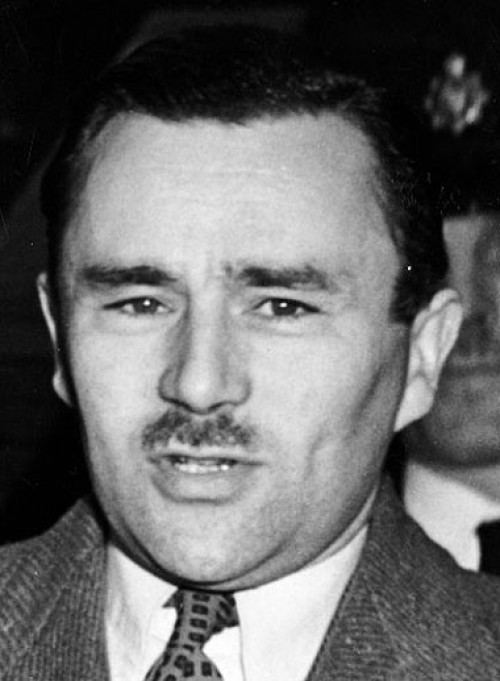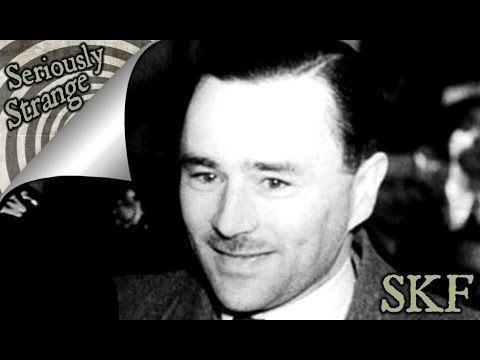Victims 6–9 Date apprehended 1949 Motive Profit Role Serial Killer | Criminal penalty Death Name John Haigh Span of killings 1944–1949 | |
 | ||
Born 24 July 1909 ( 1909-07-24 ) Stamford, Lincolnshire, England Died August 10, 1949, HM Prison Wandsworth, London, United Kingdom Education Queen Elizabeth Grammar School, Wakefield | ||
Cause of death Execution by hanging Other names The Acid Bath Murderer | ||
John george haigh serial killer file 4
John George Haigh (24 July 1909 – 10 August 1949), commonly known as the Acid Bath Murderer, was an English serial killer. He was convicted for the murder of six people, although he claimed to have killed nine. He battered or shot his victims to death and used concentrated sulphuric acid to destroy their corpses before forging papers so he could sell the victims' possessions and collect substantial sums of money.
Contents
- John george haigh serial killer file 4
- Walks in England Acid Bath Murderer in Horsham
- Early life
- Marriage and imprisonment
- Acid Bath murders
- Last victim and capture
- Trial and execution
- Haighs confirmed victims
- In popular culture
- In music
- References
During the investigation, it became apparent that Haigh was using the acid to destroy victims' bodies because he misunderstood the meaning of the term corpus delicti, and mistakenly believed that, if the bodies could not be found, a murder conviction would not be possible. Despite the absence of his victims' bodies, there was sufficient scientific evidence for him to be convicted for the murders and subsequently executed.

Walks in England - Acid Bath Murderer in Horsham
Early life

John George Haigh was born in Stamford, Lincolnshire, and grew up in the village of Outwood, West Riding of Yorkshire. His parents were engineer John Robert and Emily (née Hudson), members of the Plymouth Brethren, a conservative Protestant sect.

Haigh later claimed that he suffered from recurring religious nightmares in his childhood. Despite these limitations, Haigh developed great proficiency at the piano, which he learned at home. He was fond of classical music and often went to concerts featuring music by Felix Mendelssohn, Johann Sebastian Bach, Antonio Vivaldi, Tchaikovsky and many more.

Haigh won a scholarship to Queen Elizabeth Grammar School, Wakefield. He then won another scholarship to Wakefield Cathedral, where he became a choirboy.
After school, he was apprenticed to a firm of motor engineers. After a year, he left that job, and took jobs in insurance and advertising. At age 21, he was fired after being suspected of stealing from a cash box.
Marriage and imprisonment
On 6 July 1934, Haigh married 23-year-old Beatrice 'Betty' Hamer. The marriage soon disintegrated. The same year that Haigh was jailed for fraud, Betty gave birth while he was in prison, but she gave the baby girl up for adoption and left Haigh. His conservative family ostracised him from that point onwards.
He then moved to London in 1936, and became chauffeur to William McSwan, a wealthy owner of amusement arcades. He maintained McSwan's amusement machines. Thereafter he pretended to be a solicitor named William Cato Adamson with offices in Chancery Lane, London; Guildford, Surrey; and Hastings, Sussex. He sold fraudulent stock shares, purportedly from the estates of his deceased clients, at below-market rates. His scam was uncovered by someone who noticed he had misspelled Guildford as "Guilford" on his letterhead, an unlikely mistake from an educated solicitor. Haigh received a four-year prison sentence for fraud. Haigh was released just after the start of the Second World War; he continued as a fraudster, and was sentenced to several further terms of imprisonment.
Haigh realised that his repeated arrests stemmed from leaving victims alive to report the crime, and he became intrigued by the crimes of French murderer Georges-Alexandre Sarret, who in 1925 had disposed of his victims' bodies via sulphuric acid. While in prison, Haigh devised a method of destruction of the body of a murder victim by dissolving it in the acid. He experimented with field mice and found that it took only 30 minutes for the body to dissolve.
"Acid Bath" murders
Haigh was freed from prison in 1943 and became an accountant with an engineering firm. Soon after, by chance, he bumped into his former employer McSwan in The Goat pub in Kensington. McSwan introduced Haigh to his parents, Donald and Amy. McSwan worked for them by collecting rents on their London properties, and Haigh became envious of his lifestyle. On 6 September 1944, McSwan disappeared. Haigh later admitted hitting him over the head after luring him into a basement at 79 Gloucester Road, London SW7. He then put McSwan's body into a 40-gallon drum and tipped concentrated sulphuric acid onto it. Two days later he returned to find that the body had become sludge, which he poured down a manhole.
He told McSwan's parents that their son had gone into hiding in Scotland to avoid being called up for military service. Haigh then took over McSwan's house and began collecting the rents for his parents, but he wanted the money from the properties. Donald and Amy became curious as to why their son had not returned as the war was coming to an end. On 2 July 1945, he lured them to Gloucester Road by telling them their son was back from Scotland for a surprise visit. He murdered them in his basement with blows to the head and disposed of them.
Haigh stole William McSwan's pension cheques and sold their properties, stealing about £8,000, then moved into the Onslow Court Hotel in Kensington. Haigh was a gambler and was running short of money by the summer of 1947. To solve his financial troubles, he found another couple to kill and rob: Dr Archibald Henderson and his wife Rose, whom he murdered after feigning interest in a house that they were selling. He was invited to the Hendersons' flat by Rose to play the piano for their housewarming party. While at the flat Haigh stole Archibald Henderson's revolver, planning to use it in his next crime.
He rented a small workshop at 2 Leopold Road, Crawley, Sussex, and moved acid and drums there from Gloucester Road. Haigh was also known to have stayed at Crawley's George Hotel on several occasions. On 12 February 1948, he drove Henderson to Crawley on the pretext of showing him an invention. When they arrived, Haigh shot Henderson in the head with the stolen revolver. He then lured Mrs Henderson to the workshop, claiming that her husband had fallen ill, and shot her also.
After disposing of the Hendersons' bodies in oil drums filled with acid, he forged a letter from them and sold all of their possessions for £8,000 (except their dog and motor car, which he kept).
Last victim and capture
Haigh's next and last victim was Olive Durand-Deacon, 69, the wealthy widow of solicitor John Durand-Deacon and a fellow resident at the Onslow Court Hotel. Haigh by then was calling himself an engineer, and Olive mentioned an idea to him that she had for artificial fingernails. He invited her down to the Leopold Road workshop on 18 February 1949 and, once inside, he shot her in the back of the neck with the .38 calibre Webley revolver that he had stolen from Archibald Henderson, stripped her of her valuables, including a Persian lamb coat, and put her into the acid bath. Two days later, Durand-Deacon’s friend Constance Lane reported her missing.
Detectives soon discovered Haigh’s record of theft and fraud and searched the workshop. Police found Haigh’s attaché case containing a dry cleaner’s receipt for Mrs. Durand-Deacon’s coat, and also papers referring to the Hendersons and McSwans. The workshop in Sussex rented by Haigh did not contain a floor drain, unlike the workshop he had rented at Gloucester road in London. He therefore disposed of the remains by pouring out the container on a rubble pile at the back of the property. Investigation of the area where the sludge was poured, by pathologist Keith Simpson, revealed 28 pounds of human body fat, part of a human foot, human gallstones and part of a denture which was later identified by Mrs Durand-Deacon's dentist during the trial.
Haigh asked Detective Inspector Albert Webb during questioning, "Tell me, frankly, what are the chances of anybody being released from Broadmoor?" (a high-security psychiatric hospital). The inspector said that he could not discuss that sort of thing, so Haigh replied, "Well, if I told you the truth, you would not believe me. It sounds too fantastic to believe."
Haigh then confessed that he had killed Durand-Deacon, the McSwans and the Hendersons—as well as three other people: a young man called Max, a girl from Eastbourne, and a woman from Hammersmith. These claims could not be substantiated.
Trial and execution
After arrest, Haigh remained in custody in Cell 2 of Horsham Police Station in Barttelot Road. He was charged with murder at the nearby courthouse in what is now known as the Old Town Hall. Haigh pleaded insanity, claiming that he had drunk the blood of his victims.
He confessed to having dreams dominated by blood as a young boy. When he was involved in a car accident in March 1944, his dream returned to him: "I saw before me a forest of crucifixes which gradually turned into trees. At first, there appeared to be dew or rain, dripping from the branches, but as I approached I realized it was blood. The whole forest began to writhe and the trees, dark and erect, to ooze blood...A man went from [sic] each tree catching the blood...When the cup was full, he approached me. 'Drink,' he said, but I was unable to move." However, as stated above, he had previously asked a police officer, "What are the chances of getting out of Broadmoor?"
The Attorney-General, Sir Hartley Shawcross KC (later Lord Shawcross), led for the prosecution at Lewes Assizes, and urged the jury to reject Haigh’s defence of insanity because he had acted with malice aforethought.
Sir David Maxwell Fyfe KC, defending, called many witnesses to attest to Haigh’s mental state, including Dr Henry Yellowlees, who claimed Haigh had a paranoid constitution, adding: "The absolute callous, cheerful, bland and almost friendly indifference of the accused to the crimes which he freely admits having committed is unique in my experience."
It took only minutes for the jury to find Haigh guilty. Mr Justice Travers Humphreys sentenced him to death.
It was reported that Haigh, in the condemned cell at Wandsworth Prison, asked one of his prison guards, Jack Morwood, whether it would be possible to have a trial run of his hanging so everything would run smoothly. It is likely that his request went no further, or, if it did, the request was denied. Haigh was led to the gallows and hanged by executioner Albert Pierrepoint on 10 August 1949.
The case of John George Haigh was one of the post-1945 cases which gained considerable coverage in the newspapers even though Haigh's guilt was not questioned. The editor of the Daily Mirror, Silvester Bolam, was sentenced to a prison term for contempt of court for describing Haigh as a "murderer" while the trial was still under way.
